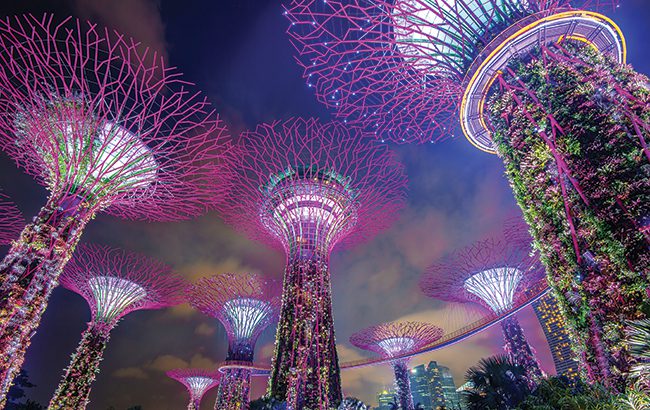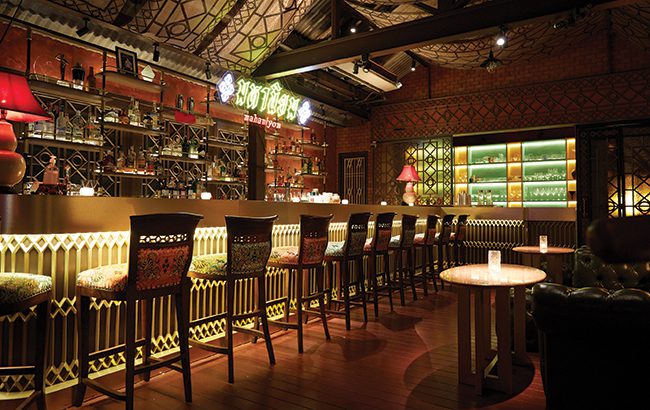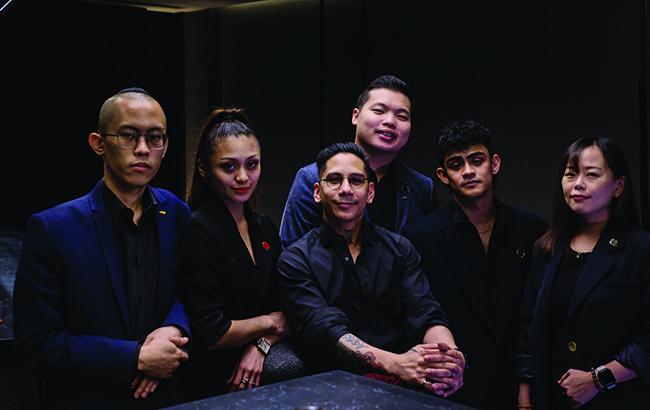Global Bar Report 2023: Asia
Cities throughout Asia are catching up to the big hitters, from Singapore and Tokyo to Kuala Lumpur and Guangzhou.

With the Covid-19 pandemic now firmly in the rear-view mirror for Asia, international tourism is slowly returning to the continent, and the hospitality industry is picking up the pace from where it left off. In the mid-2010s, Asia bar scene cemented itself as a global cocktail hub –with dozens of establishments earning international acclaim in the media and in global rankings. Today, there’s never been a more exciting time to be drinking in Asia.
“Coming out of Covid was such a relief for the industry, and the return of tourism has given us a much-needed breath of fresh air,” says Jiawei Bai, founder of Singapore’s White Shades and Stay Gold Flamingo. “The crowds came back gradually, things started picking up, and now it’s almost back to normal.”
While it can be tricky to draw broad conclusions about a continent so vast and varied, it might be posited that the bar scene in Asia is entering a third wave. In the first, highly developed cities like Singapore, Hong Kong and Tokyo learned and perfected the craft cocktail traditions of the west. Japanese whisky rose to prominence. In the second, emerging bar hubs like Bangkok, Seoul, and Taipei burst onto the scene. Local operators came to the forefront, opening their own concepts using local flavours to craft cocktails with a sense of place.
“We are the first Thai cocktail bar that is owned and run by Thai people,” says Ronnaporn ‘Neung’ Kanivichaporn, co-owner of Bangkok’s Locker Room and Mahaniyom Cocktail Bar, whose menus spotlight ingredients such as tamarind, turmeric, and Thai agricole rum. “We can put Bangkok and Thailand on the map of the cocktail world.”
Now Asian bars are not only tackling trends but are leading the way as global thought leaders in bar ingredients, sustainability, and design. Elsewhere on the continent, previously under-represented markets like Ho Chi Minh City in Vietnam, Kuala Lumpur in Malaysia, and Guangzhou in China, have burst onto the scene, making inroads into global and regional rankings, and introducing even more speciality ingredients and culinary ideas into the mix.
At Vietnam’s Hybrid, bartender Phu ‘Phil’ Nguyen says bartenders are more proud to channel their own culture into cocktail form – drawing a stronger connection between food and drink. “They are proud to share local ingredients and spirits through cocktails,” he says. “When our customers see drinks named after Vietnamese dishes, it reminds them of their own memories.”
A similar approach can be found at MO Bar, at the Mandarin Oriental, Singapore, which is showcasing its Exceptionally Singapore-themed menu that celebrates ingredients representing the city’s diverse Chinese, Malay, and Indian populations.
“Sustainability and locally sourced ingredients have become prominent trends,” says Marcel Li, director of food and beverage at the hotel. “Consumers are increasingly conscious of the environmental impact of their choices, leading to a focus on eco-friendly practices and creative use of regional ingredients. We’ve partnered with local suppliers to source sustainable produce.”
According to Henry Stonham, the Singapore-based project manager for the Bar Convent Berlin (BCB) franchise, there’s a hunger throughout the Asia bar scene, but particularly in emerging markets, where bar teams frequently participate in regional events, and host guest bartenders from all over the world for takeovers and pop-ups.
Speaking about the region’s collaborative and supportive spirit, BCB Singapore in November was due to host a Homegrown Heroes event featuring bartenders from Hybrid, along with the Philippines’ ReCraft, and Malaysia’s Penrose.
“Eyes are on cities such as Ho Chi Minh City and Kuala Lumpur, as these markets have rich cultures and unique ingredients,” Stonham explains. “Places to watch are Penang, which is hosting its first Penang Cocktail Week; Cambodia is also a rising country in the region. One of the most exciting things about these markets is the quickly developing pool level of talent, driven by an insatiable passion to learn and grow the local bar community.”
Asia’s growth in the bar scene was on full display in October, when the World’s 50 Best Bars list was unveiled in Singapore, marking the first time in its 15-year history that the event had been held outside of Europe. Included on the list were two bars apiece from Tokyo, Hong Kong, Bangkok, and Singapore – whose retro-futuristic saloon Night Hawk nabbed the first award for Best Bar Design. Rounding out the list was Seoul-based zero-waste newcomer Zest, which cracked the list at number 18, taking home an award for highest new entry.
“Consumers here are more focused on lifestyle now,” explains White Shades’ Bai. “For example; a night out might depend on their mood and where they feel like being for the evening. At White Shades, we have options – our guests can choose to head to level two for a more bespoke experience, with cocktails crafted by our amazing bartenders. Or they could head to the rooftop, for more casual and affordable draft cocktails.”
Beyond more thoughtfulness in sustainability and bar design, other trends cited by regional bartenders included modern high-volume bars, pre-mixed cocktails served on tap, and low-ABV cocktails with an emphasis on health.
“The Asian bar scene is prominent and flourishing – our diverse venues have all types of styles, experiences, atmospheres and hospitality to offer guests which keep the scene fresh and exciting yet still in good competition,” says Sasha Wijidessa, owner of Singapore’s Fura. “We feel that now more than ever the consumer is educated in what they want or like to drink which pushes venues to the next level.”
Speaking about emerging markets outside of Singapore, Wijidessa adds: “You have a very young industry that’s mostly introducing new, innovative, and forward-thinking venues to the community.”
Bars to watch in 2024
Mahaniyom Cocktail Bar — Bangkok, Thailand

Created by Locker Room and Back Stage bartenders Ronnaporn ‘Neung’ Kanivichaporn and Chennarong ‘Janz’ Bhumichitr, Mahaniyom opened in 2022 on the second floor of nose-to-tail northern Thai restaurant 100 Mahaseth in Sri Phaya. The high-energy bar – whose name translates to ‘very popular’ – spotlights cocktails made sustainably using all parts of a single ingredient, from flower to root. Take, for example, the Tamarind, which employs ripe fruit for sweetness, young fruit and leaves for tartness, and seeds for a roasted flavour. The Cow, meanwhile, made use of beef fat and dairy products such as brown butter and clarified milk. The bar’s decor is likewise freewheeling, combining traditional Thai aesthetics and tiger imagery with global accents.
Fura – Singapore
Gastronomy and mixology come together at Fura, the bar opened in August 2023 by chef Christina Rasmussen and bartender Sasha Wijidessa, who also looks after the Copenhagen-based free-form spirits maker Empirical Spirits in Asia. Creative sustainability is the mantra at Fura, which serves such concoctions as a Jellyfish Martini using jellyfish-infused gin – a nod to how rising sea temperatures have turned jellyfish into an invasive pest. More conventional offerings include a rum-based Juicy Fruit, spotlighting tropical flavours like jackfruit, pineapple, and banana. On the food front, there are plant-based creations such as hot dogs, made with carrot ‘sausage’, and ‘caviar’ made with black garlic.
Penrose – Kuala Lumpur, Malaysia

Opened in 2022 in Kuala Lumpur’s colourful Chinatown neighbourhood, Penrose is an elevated, visually minimalist bar with geometric steampunk sensibilities. Created by culinary-trained bartender-owner Jon Lee, the menu is guided by the five cardinal pillars of cocktails: alcohol, flavour, taste, body, and dilution. The house signature, Rum Musa, riffs on a classic Banana Daiquiri with Southeast Asian flavours from the Malaysian banana plant. Meanwhile, a classic Martini accents gin with plum and lava salt. The bar spotlights counter seating, encouraging conversations with the bartender. The capacity is only 25, so reserve your spot ahead of time.
Related news
Amaro Santoni champions aperitivo in London
